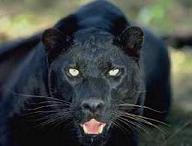Black Panther Sightings In Monroe, Michigan
Posted by: Loren Coleman on August 13th, 2012

Standard black panther file photo.
A large feline spotted Sunday [March 31, 2012] near Grand Court Adrian has been identified by a law enforcement official as a black panther.
Trooper Sean Street from the Monroe post of the Michigan State Police responded at 5:51 p.m. to a report of a large feline walking in the field, according to a news release. Upon arriving at the scene, he watched the animal, approximately 2 feet in height and weighing about 30 pounds, walk across the field about 75 yards away and into a nearby woods.
Doesn’t 30 pounds seem a bit small for a reportedly “large” Mystery Black Panther? A mountain lion female weighs between 64 and 141 pounds, and males can be as large as 220 pounds. Leopards weigh from 66 to 200 pounds for males, and 51 to 130 pounds for females.
“There is no doubt it was a panther,” Street said. “It was identical to what you see in National Geographic Magazine.”
(What is a exactly does it mean to say some cat is a “panther”? There are many meanings to the word. For more exact information, see here.)
Street said the panther did not appear to be aggressive, but he urges residents to be cautious and contact law enforcement officials if they spot the animal nearby, reported the Daily Telegraph.
Thanks to Chad Arment.
About Loren Coleman
Loren Coleman is one of the world’s leading cryptozoologists, some say “the” leading living cryptozoologist. Certainly, he is acknowledged as the current living American researcher and writer who has most popularized cryptozoology in the late 20th and early 21st centuries.
Starting his fieldwork and investigations in 1960, after traveling and trekking extensively in pursuit of cryptozoological mysteries, Coleman began writing to share his experiences in 1969. An honorary member of Ivan T. Sanderson’s Society for the Investigation of the Unexplained in the 1970s, Coleman has been bestowed with similar honorary memberships of the North Idaho College Cryptozoology Club in 1983, and in subsequent years, that of the British Columbia Scientific Cryptozoology Club, CryptoSafari International, and other international organizations. He was also a Life Member and Benefactor of the International Society of Cryptozoology (now-defunct).
Loren Coleman’s daily blog, as a member of the Cryptomundo Team, served as an ongoing avenue of communication for the ever-growing body of cryptozoo news from 2005 through 2013. He returned as an infrequent contributor beginning Halloween week of 2015.
Coleman is the founder in 2003, and current director of the International Cryptozoology Museum in Portland, Maine.










I do not understand why black cats are even discussed in the crypto world, I mean it’s not a cryptid, so why talk about it?
Naus, have you not been here long?
Black panthers, melanistic mountain lions, and black cougars, whatever you want to call them, are not suppose to exist in the United States and Canada, but people keep on seeing them. Throughout the upper Midwest, it is well-known for its long history of cryptozoological Black Panthers.
There just are not suppose to be any “black panthers” – i.e. melanistic large felids – in North America. Yes, mountain lions exist probably throughout NA (they are still “cryptids” in the East), but black mountain lions are not verified zoologically. Black leopards and black jaguars are known, however, they do not naturally live in North America.
America’s Black Panthers are, therefore, a cryptid population with a well-established legacy, for example, that inhabits several pages of reports in my book, Mysterious America, via an entire chapter and an appendix.
Just read Robert Tougias’ recent, “The Quest for the Eastern Cougar.” It even refers to Loren! It changed my mind about “American melanistic panthers.” While I might think almost 99% of reported large blacksightings are large feral black cats or dogs or as evidenced in Florida, melanistic bobcats, Tougias’ research leaves open the possibility of extremely rare melanistic cougars.
And I would think the hows, whys and huhs would be enough to fascinate anyone interested in “cryptozoology.”